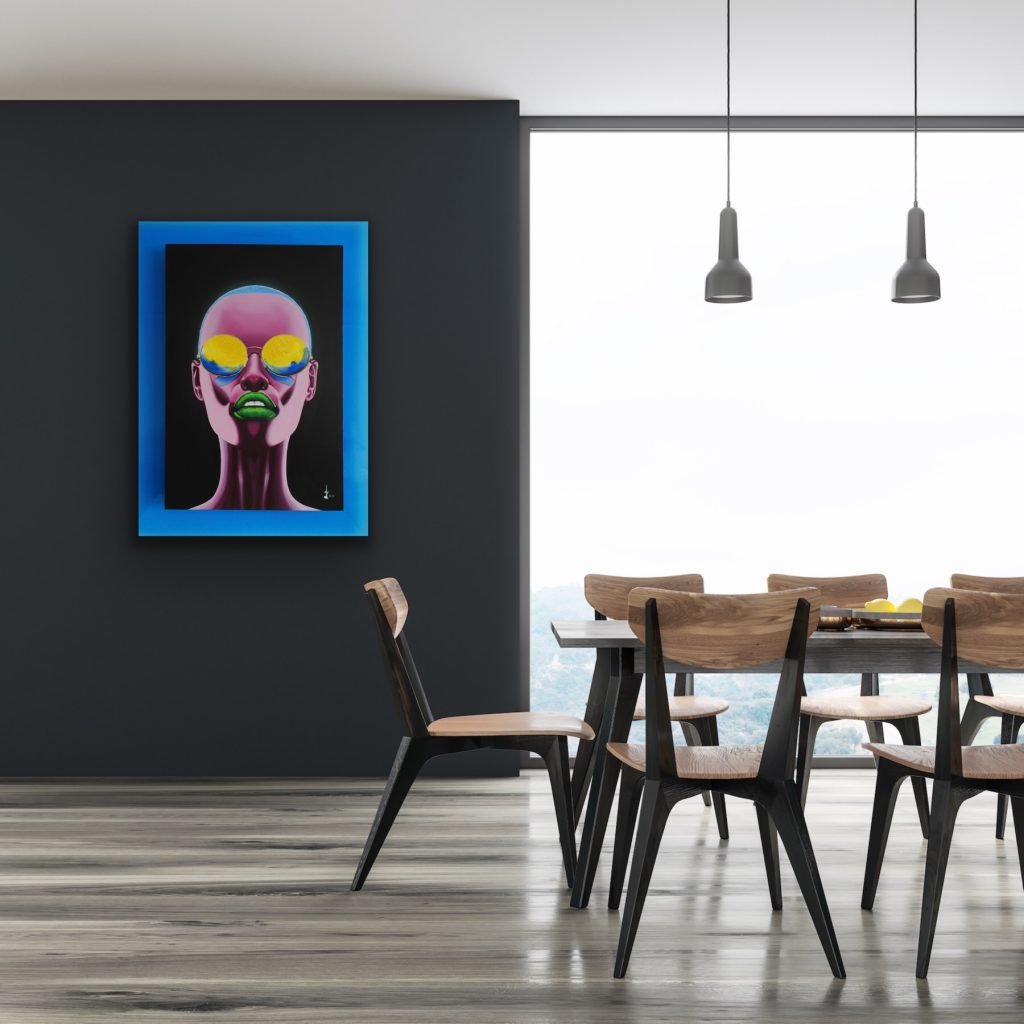|
Listen to article
|

Squadron leader Rakesh Sharma was the first Indian to journey into space in 1984, and the first woman astronaut of Indian origin, an Indian-American, Kalpana Chawla, flew on the Space Shuttle in 1997 and in 2003.
Lakshmi Mohanbabu is the first artist of Indian origin (but a Singaporean citizen) whose art work will have a permanent place on the Moon by 2022. Selected by the European Space Agency (ESA), for their Project Moon – Mars Mission to be launched in 2022, Lakshmi’s artwork will be featured among the works of 100 artists from around the world to be exhibited on the surface of the moon!
Her work has already been featured as a mosaic animation on the largest HD screen in the world at Singapore’s Suntec City, in famous galleries and can now be viewed at Singapore’s iconic Raffles hotel too!
In this interview for India Foundation’s Centre For Public Diplomacy & Soft Power with Ms. Pavithra Srinivasan, Lakshmi talks about her many talents, multifaceted approach to art, multitude of disciplines and her unplanned ‘journey’ to the Moon.
Pavithra: Sounds, symbols, signs are a language of their own because of the intrinsic messages they carry and convey. They facilitate understanding, imaginations, interpretations, set narratives and can translate even complex ideas into simple images. You have used several symbols & colours in your paintings and designs. What messages do they give?
Lakshmi: An ideology everyone can connect with is our existence – the creation of new life and life cycles. We belong to different races, cultures and geographical regions, but our symbols do have common threads – being interconnected, interrelated and interdependent. The use of different colours in the interactions series depicts diversity in our thought and appearance, interconnected existence, our patterns of migration, assimilation and integration.

Pavithra: The word mandala meaning a circle in Samskritam has its origin in Hinduism as a symbolic diagram used in the performance of sacred rites and an instrument of meditation. It represents the enormity of the universe and the cyclical nature of life. What inspired you to use the Mandala in your paintings?
Lakshmi: The Mandala has a universal message and represents the microcosm and the macrocosm – the world that exists both beyond and within our bodies and minds. In it lies the ideology of being one with the universe which belongs to everyone and has no geographical or racial boundaries. It is a philosophy that I found has parallels in different cultures and could be translated into a global language of symbols. That thought really inspired me!

Pavithra: What was the underlying idea behind the Interaction cube being sent to the moon and the process involved in its creation?
Lakshmi: The interaction cube is based on my ‘Interactions’ series of paintings. I have interpreted number concepts into philosophical ideas of the singularity of the self; the duality of complementary and interdependent sides; the trinity of preservation, creation and destruction; the quaternity of the four directions; the plurality in our belief systems and infinity of time and thought.
The moon has extreme temperatures – nights and days that last two weeks each. Temperatures go up and down roughly from +130°C to -280°C.
I have collaborated with Nanyang Technological University, Singapore (NTU) to create prototypes for the cube in order to get the geometry, material and colour right. We have finally decided on anodised aluminium. It gave us the best choice in terms of weight, colour and durability. Prototypes have been made in different metals – steel, Inconel, titanium and anodised aluminium using different manufacturing methods. NTU has created the entire set of Interaction cubes from the Interactions series.

Pavithra: How has Indian Art & design influenced your art? What have Indian arts imbibed from other cultures?
Lakshmi: We are a migrant mix of Indo-European, Dravidian, Turko- Mongolian and East-Asian peoples, which has made India quite literally the very first melting pot of cultural assimilation. This interesting mix is seen reflected in its arts and crafts and an early advancement in the philosophical and mathematical fields. As an artist, this has inspired me greatly.
Our Architecture, Language, Philosophy, Clothing, Textiles and Crafts are the fruits of historical global interactions. Each successive migration has brought in its influence, be it miniature paintings, calligraphy, Pietra dura and architectural styles – the use of the dome, the arch or in our draped costumes to name a few in the arena of arts.

Pavithra: How have you incorporated your multifaceted background and works in your paintings? Do your other works also blend art, science, and philosophy?
Lakshmi: I spent most of my childhood in a very close-knit multicultural international community in Russian occupied Afghanistan. It developed my understanding of subtle and obvious differences and similarities in cultures, dress, language and cuisine. I come from a family that is artistically inclined and aware of social issues such, as gender bias, racial discrimination and economic disparity. There was a constant exchange of ideas.
My training in architecture helps me to curate and conceptualise space, understand the form, perspective and sciography (the study of light, shade and shadow). At NIFT-Delhi, I taught in the departments of Apparel Marketing & Merchandising, Knitwear Design, Textile Design, Fashion Design and Information Technology. This gives me a fair understanding of indigenous and global arts, crafts, textiles and architecture. I illustrated books for the Voluntary Health Association of India and the World Health Organisation (WHO). The Illustrations had to be applicable and relevant to the Indian rural setting in the area of disability.
Each of these has taught me something different. My ‘Expression’ series, as well as the ‘colour spectrum – colours of unity’ series, follow the concept of integrating art, science and philosophy. The ups and downs of life are reflected in the crest and trough of the wave. All my painting series follow this concept of duality seen in waveforms.

Pavithra: What challenges have you overcome in your journey as a contributor to the Arts & Design world?
Lakshmi: As an Architect and Fashion designer, I realise there are very distinct boundaries in the art and design fields. Very often getting through pre-conceived notions is what I found most challenging. For instance: The Architect reigns supreme; the Fashion designer has a frivolous occupation considering we would like to be clothed before we are housed; the Photographer is an intellectual unlike the Fashion designer; the Artist whose work is ambiguous is a genius and then again being an artist is obviously just a hobby that pays no bills!
Design is an area populated by self-styled experts. Having the freedom to design what I want and follow my own path without being offered unsolicited advice has been challenging, at times extremely frustrating and yet amusing!
As someone who has dabbled in all these fields, I end up having to ward off the various labels. Getting taken seriously, gallery representation, building up a client base were major hurdles especially when I definitely know my work as different!

Pavithra: How do you think the economics and commerce of the Art industry grow globally? What is lacking right now, areas for improvement?
Lakshmi: The originality of an artist lies in a new interpretation of an existing idea. This is challenging and not easily achieved. I have studied the works of numerous successful artists. This was to better understand how they were able to deviate from mainstream trends and create works that had an approach that was unique. Having said that, art is highly subjective and open to individual perceptions.
In India, we have too many middlemen. I do see a huge overlap in space in the works of contemporary artists and folk artists. Very often the line dividing the two is indistinguishable. Indian folk and tribal arts do have great potential to be developed. These are techniques, traditions and skills handed down from one generation to the next. Global collaborations and exchange programmes for our artists will help them develop new skills. They can share their knowledge while developing and enhancing their own existing talents. There is no reason to believe that they should not have room for innovation.
Involvement by educational institutions to share their knowledge to encourage indigenous art would create exposure. It will also motivate artists to innovate within their own style of work. Use of technology and social media will increase awareness of both our art and artists in a global audience. An example can be seen in Australian Aboriginal art, which has been given that impetus resulting in global interest with its share of collectors.

Pavithra: How do you feel being the first Singaporean artist selected for this extraordinary Moon Mars Mission? Would you also like to aim to travel to the moon – literally?
Lakshmi: I feel very honoured to have my work selected and to be the first Singaporean to be in the moon gallery. The ideology behind the interaction cube is one that I have spent a quarter-century working on and is very close to my heart, which makes it all the more special to have had it chosen.
Growing up I was told to aim for the moon; it is hard to believe that my interaction cube will make it a reality! I would love to paint the earth from the moon! That will be an incredible experience! Nonetheless, come 2022 whenever I look up at the moon, I will know that something I created has travelled to the moon and will remain for eternity in space.
For Lakshmi Mohanbabu sky has not been the limit; come 2022, she will her handprints on the Moon!






Thank you Pavithra what an amazing movement you and Rajeev have started so proud to be part of it, Thank you for having me on your platform
Our pleasure to write about your extraordinary achievement dear Lakshmi.
Lakshmi, congratulations.. Great to have ones creation reach the moon. A great achievement. Wish you greater success. This is to mention you created the symbol of our Foundation . It is unique.
Dear Dr Susheela,
Thanks a lot for your appreciation.
Thankyou for your kind comments Dr. Susheela Ji.
dear lakshmi, to give credit where it’s due, you and my good friend pavithra did a terrific job here. kudos to both of you and the india foundation for nurturing the Soft Power thrust for india. my role was merely as a messenger introducing you and your stunning work to pavithra, who’s an equally impressive dancer turned soft power advocate.
Thankyou for your warm note Rajeev.
Thank you really appreciate your kind words. I am proud to be part of the movement.
Very interesting and motivating interview. Congratulations to Lakshmi Mohanbabu for reaching her artworks ‘on the moon’. A proud achievement for any artist. We Indians are happier because when our Chandayaan makes regular trips to the moon starting from next year, it will find one of our own present there through the artwork from 2022 onwards.
Good interview Pavithra!!
Thank you Sri Ram Madhav Ji, for the oppurtunity to interview Ms Lakshmi & your kind words of appreciation.
Thankyou for the oppurtunity Sri Ram Madhav Ji, to interview Ms Lakshmi , & your kind words of appreciation.
Thanks ram really appreciate the same.
Very Interesting
Glad you liked it Sir .